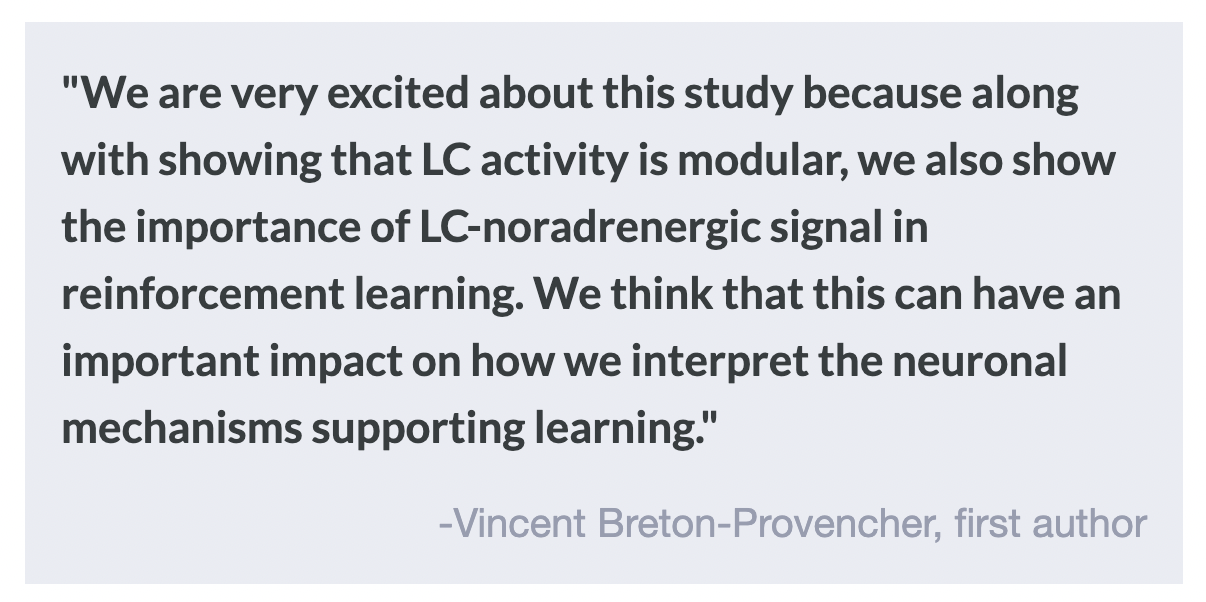Two Distinct Functions of Noradrenaline
Post by Shireen Parimoo
The takeaway
The locus coeruleus (LC) is a small brainstem structure that releases noradrenaline, which has both specific and widespread effects on cortical regions. Distinct populations of neurons in LC have distinct roles during the expression of learned behaviors, including coding for unexpected and expected rewards and punishment.
What's the science?
The locus coeruleus (LC) is a small nucleus in the brainstem that produces noradrenaline in the brain. Noradrenaline has a variety of effects on cognition, including regulating arousal, sleep, attention, and decision-making processes. LC function is difficult to study in humans because of its small size. It was previously thought to be a homogenous structure. However, new animal studies indicate that different sub-populations of LC neurons may project to different cortical regions and therefore play a role in distinct cognitive processes. This week in Nature, Breton-Provencher and colleagues used optogenetics and in vivo imaging techniques to investigate the functional organization of LC neurons.
How did they do it?
Activity from LC neurons was recorded while mice performed an auditory go/no-go task, in which they were trained to press a lever in response to “go” tones and withhold a lever press in response to “no-go” tones. The tones varied in volume, which allowed the authors to determine whether stimulus intensity influenced LC activity. Mice were rewarded on correct hit trials (i.e., when the mice pressed the lever in response to the go tone) and punished with an air puff on false alarm trials (i.e., when the mice pressed the lever in response to the no-go tone). No reinforcement was provided on missed trials (did not press the lever on go trials), but an unexpected reward was randomly delivered on a few correct rejection trials (did not press the lever on no-go trials). In addition to the hit and false alarm rates, the authors also estimated the probability of pressing the lever on a given trial.
They examined the impact of optogenetic inhibition on LC activity and behavior, both on the current trial and the subsequent trial. The authors optogenetically inhibited activity in LC neurons during tone onset, lever press, and reinforcement. Additionally, they identified populations of LC neurons that projected to the motor cortex and the dorsomedial prefrontal cortex (DMPFC) with retrograde tracing. To examine the impact of LC input to cortical regions on behavior, they inhibited LC axons specifically in motor cortex and DMPFC using optogenetics.
What did they find?
High-intensity tones improved performance on both go and no-go trials. That is, mice were more likely to press the lever when the go tone intensity was high (i.e., louder) and conversely, less likely to press the lever when the no-go tone intensity was high. In the absence of optogenetic inhibition, punishment increased the probability of lever pressing for go tones on the subsequent trial, but this effect was eliminated with LC inhibition. Expected rewards led to an increase in hit rates whereas unexpected rewards increased false alarms. However, LC inhibition during expected rewards had no impact on behavior, but it reduced the false alarm rate following unexpected reward delivery, demonstrating that the LC differentially codes for surprising compared to expected positive reinforcement.
Different subpopulations of LC neurons were active during false alarms compared to correct hits, and spike rates of LC neurons increased (1) right before mice pressed the lever, and (2) after reinforcement delivery. The increase in spiking activity prior to lever pressing was positively related to go tone intensity and did not differ between hits and false alarms. Lever pressing was associated with greater input from LC to the motor cortex. On the other hand, punishment, but not reward, led to greater activity in the LC that was distributed homogenously in both the motor cortex and DMPFC. Spiking activity also increased after the delivery of unexpected rewards, regardless of tone intensity. Photoinhibition of LC axons in the motor cortex impaired behavior in all trials, whereas inhibiting the DMPFC had no impact on behavior. Together, these results show that distinct LC neurons are activated at different time points, with differential roles in motor responding for task execution and processing reinforcement to improve performance accuracy.
What's the impact?
This study demonstrates that different sub-populations of the locus coeruleus are involved in the preparation of motor responses and in learning related to the delivery of rewards and punishment. These findings are crucial for improving our understanding of the functional organization of the locus coeruleus and its role in various cognitive processes.


